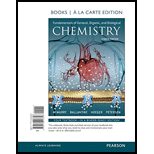
Fundamentals of General, Organic, and Biological Chemistry, Books a la Carte Edition (8th Edition)
8th Edition
ISBN: 9780134218328
Author: John E. McMurry, David S. Ballantine, Carl A. Hoeger, Virginia E. Peterson
Publisher: PEARSON
expand_more
expand_more
format_list_bulleted
Concept explainers
Question
Chapter 18, Problem 18.71AP
Interpretation Introduction
Interpretation:
Hydrogen bonding is covalent or noncovalent is to be identified.
Concept introduction:
Many amino acids are linked together through amide bonds to form a biologically large molecule known to be proteins.
Amino functional group is
Hydrogen atom when bonded to a highly electronegative atom that has an unpaired, electron pair creates hydrogen bonding.
Expert Solution & Answer
Want to see the full answer?
Check out a sample textbook solution
Students have asked these similar questions
Is hydrogen bonding covalent or noncovalent?
are covalent bonds positive
What is Covalent Chemical Bonds?
Chapter 18 Solutions
Fundamentals of General, Organic, and Biological Chemistry, Books a la Carte Edition (8th Edition)
Ch. 18.2 - Prob. 18.1PCh. 18.2 - Prob. 18.2PCh. 18.3 - Prob. 18.3PCh. 18.3 - Examine the ball-and-stick model of valine in the...Ch. 18.3 - Indicate whether each of the following molecules...Ch. 18.3 - Prob. 18.6PCh. 18.3 - Prob. 18.7KCPCh. 18.3 - Prob. 18.8PCh. 18.3 - Prob. 18.9PCh. 18.3 - Prob. 18.10P
Ch. 18.3 - Prob. 18.11PCh. 18.3 - Prob. 18.12PCh. 18.4 - The proteins collagen, bovine insulin, and human...Ch. 18.4 - Prob. 18.2CIAPCh. 18.4 - Prob. 18.13PCh. 18.4 - Prob. 18.14PCh. 18.5 - Valine is an amino acid with a nonpolar side...Ch. 18.5 - Tripeptides are composed of three amino acids...Ch. 18.5 - Prob. 18.17PCh. 18.5 - Identify the amino acids in the following...Ch. 18.5 - Prob. 18.19PCh. 18.5 - Prob. 18.3CIAPCh. 18.5 - Prob. 18.4CIAPCh. 18.5 - Two of the most complete (balanced) proteins...Ch. 18.6 - Prob. 18.6CIAPCh. 18.6 - Prob. 18.7CIAPCh. 18.6 - (a)What atoms are present in a planar unit in a...Ch. 18.6 - Prob. 18.21PCh. 18.6 - Prob. 18.22PCh. 18.7 - Prob. 18.23PCh. 18.7 - Prob. 18.24PCh. 18.7 - Complete the following two sentences with either...Ch. 18.7 - Prob. 18.26KCPCh. 18.8 - Which of the following pairs of amino acids can...Ch. 18.8 - Look at Table 18.3 and identify the type of...Ch. 18.8 - In Figure 18.3, identify the amino acids that have...Ch. 18.8 - Prob. 18.30PCh. 18.9 - Prob. 18.31PCh. 18.10 - Another endoprotease is trypsin. Trypsin...Ch. 18.10 - Prob. 18.33PCh. 18.10 - Prob. 18.8CIAPCh. 18.10 - Prob. 18.9CIAPCh. 18 - Draw the structure of the following amino acids,...Ch. 18 - Prob. 18.35UKCCh. 18 - Prob. 18.36UKCCh. 18 - Prob. 18.37UKCCh. 18 - Prob. 18.38UKCCh. 18 - Threonine has two chiral centers. Draw L-threonine...Ch. 18 - Name four biological functions of proteins in the...Ch. 18 - Prob. 18.41APCh. 18 - Prob. 18.42APCh. 18 - Prob. 18.43APCh. 18 - Prob. 18.44APCh. 18 - Prob. 18.45APCh. 18 - Prob. 18.46APCh. 18 - Prob. 18.47APCh. 18 - Draw leucine and identify any chiral carbon atoms...Ch. 18 - Prob. 18.49APCh. 18 - Prob. 18.50APCh. 18 - Is histidine hydrophilic or hydrophobic? Explain...Ch. 18 - Prob. 18.52APCh. 18 - At neutral pH, which of the following amino acids...Ch. 18 - Prob. 18.54APCh. 18 - Prob. 18.55APCh. 18 - Prob. 18.56APCh. 18 - Prob. 18.57APCh. 18 - Proteins are usually least soluble in water at...Ch. 18 - Prob. 18.59APCh. 18 - Prob. 18.60APCh. 18 - Prob. 18.61APCh. 18 - Prob. 18.62APCh. 18 - Prob. 18.63APCh. 18 - (a)Identify the amino acids present in the peptide...Ch. 18 - Prob. 18.65APCh. 18 - Prob. 18.66APCh. 18 - Prob. 18.67APCh. 18 - Prob. 18.68APCh. 18 - Prob. 18.69APCh. 18 - Prob. 18.70APCh. 18 - Prob. 18.71APCh. 18 - Prob. 18.72APCh. 18 - Prob. 18.73APCh. 18 - Prob. 18.74APCh. 18 - Prob. 18.75APCh. 18 - What kind of bond would you expect between chains...Ch. 18 - Is the bond formed between each pair in Problem...Ch. 18 - Prob. 18.78APCh. 18 - Prob. 18.79APCh. 18 - Prob. 18.80APCh. 18 - Prob. 18.81APCh. 18 - Prob. 18.82APCh. 18 - Prob. 18.83APCh. 18 - Prob. 18.84APCh. 18 - Prob. 18.85APCh. 18 - Prob. 18.86APCh. 18 - Prob. 18.87APCh. 18 - Prob. 18.88APCh. 18 - Give an example of a protein that has quaternary...Ch. 18 - Prob. 18.90APCh. 18 - Prob. 18.91APCh. 18 - Prob. 18.92APCh. 18 - Prob. 18.93APCh. 18 - Prob. 18.94APCh. 18 - Prob. 18.95APCh. 18 - Prob. 18.96APCh. 18 - Prob. 18.97APCh. 18 - Prob. 18.98CPCh. 18 - Prob. 18.99CPCh. 18 - Prob. 18.100CPCh. 18 - Prob. 18.101CPCh. 18 - Prob. 18.102CPCh. 18 - Prob. 18.103CPCh. 18 - Prob. 18.104CPCh. 18 - Prob. 18.105CPCh. 18 - Prob. 18.106CPCh. 18 - Prob. 18.107CPCh. 18 - Prob. 18.108CPCh. 18 - Prob. 18.109GPCh. 18 - Prob. 18.110GPCh. 18 - Prob. 18.111GPCh. 18 - Prob. 18.112GP
Knowledge Booster
Learn more about
Need a deep-dive on the concept behind this application? Look no further. Learn more about this topic, biochemistry and related others by exploring similar questions and additional content below.Similar questions
arrow_back_ios
SEE MORE QUESTIONS
arrow_forward_ios
Recommended textbooks for you
 Concepts of BiologyBiologyISBN:9781938168116Author:Samantha Fowler, Rebecca Roush, James WisePublisher:OpenStax College
Concepts of BiologyBiologyISBN:9781938168116Author:Samantha Fowler, Rebecca Roush, James WisePublisher:OpenStax College Human Biology (MindTap Course List)BiologyISBN:9781305112100Author:Cecie Starr, Beverly McMillanPublisher:Cengage Learning
Human Biology (MindTap Course List)BiologyISBN:9781305112100Author:Cecie Starr, Beverly McMillanPublisher:Cengage Learning Biology: The Dynamic Science (MindTap Course List)BiologyISBN:9781305389892Author:Peter J. Russell, Paul E. Hertz, Beverly McMillanPublisher:Cengage Learning
Biology: The Dynamic Science (MindTap Course List)BiologyISBN:9781305389892Author:Peter J. Russell, Paul E. Hertz, Beverly McMillanPublisher:Cengage Learning

Concepts of Biology
Biology
ISBN:9781938168116
Author:Samantha Fowler, Rebecca Roush, James Wise
Publisher:OpenStax College

Human Biology (MindTap Course List)
Biology
ISBN:9781305112100
Author:Cecie Starr, Beverly McMillan
Publisher:Cengage Learning


Biology: The Dynamic Science (MindTap Course List)
Biology
ISBN:9781305389892
Author:Peter J. Russell, Paul E. Hertz, Beverly McMillan
Publisher:Cengage Learning
Macromolecules | Classes and Functions; Author: 2 Minute Classroom;https://www.youtube.com/watch?v=V5hhrDFo8Vk;License: Standard youtube license